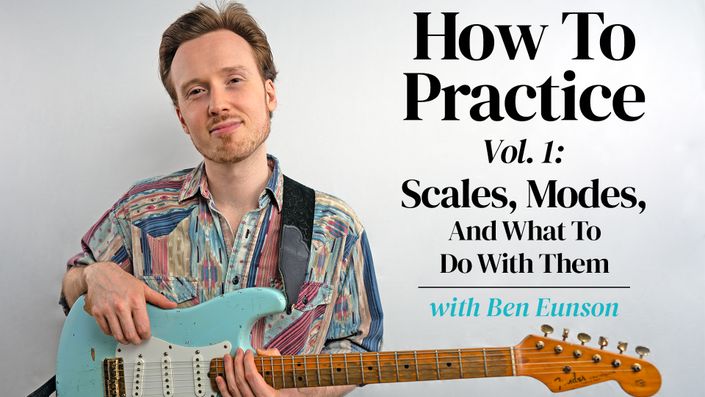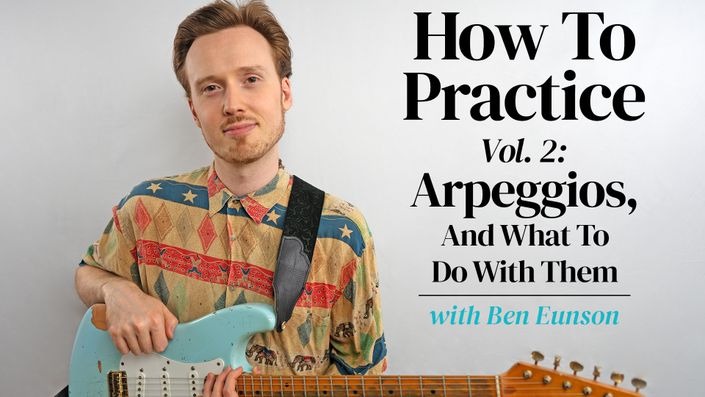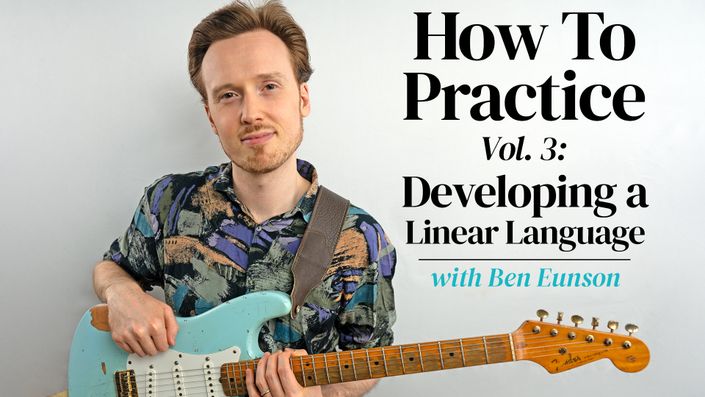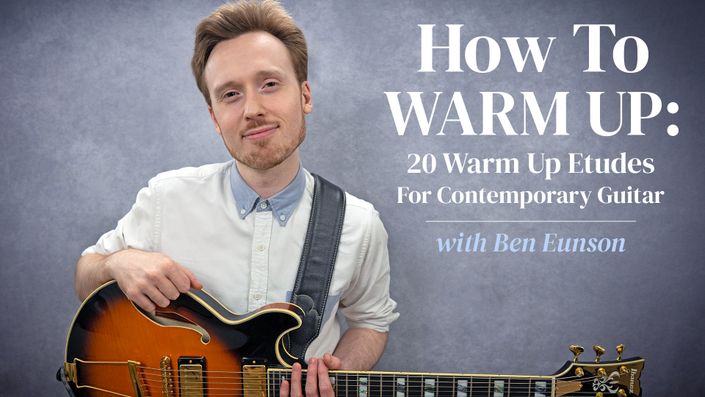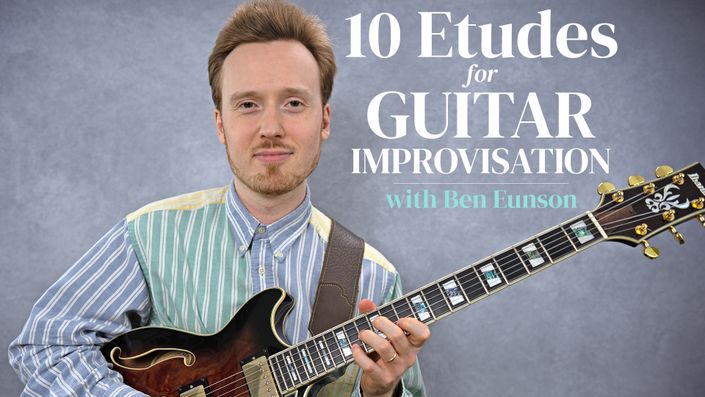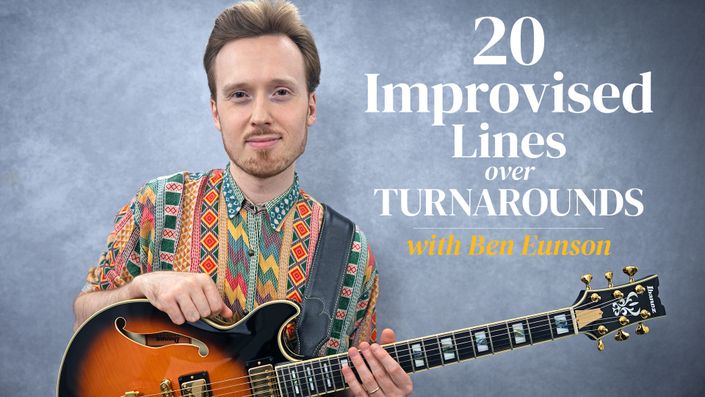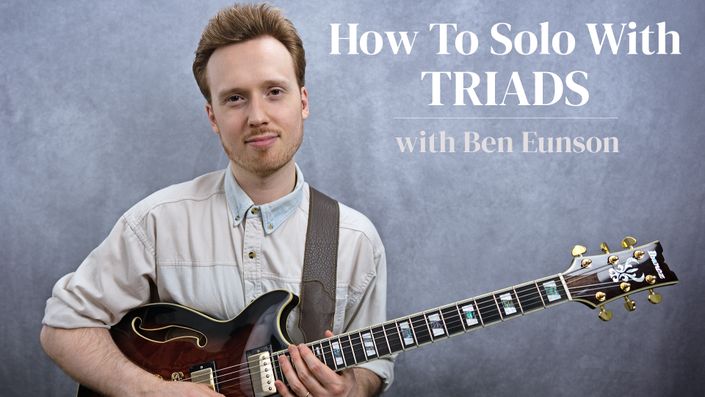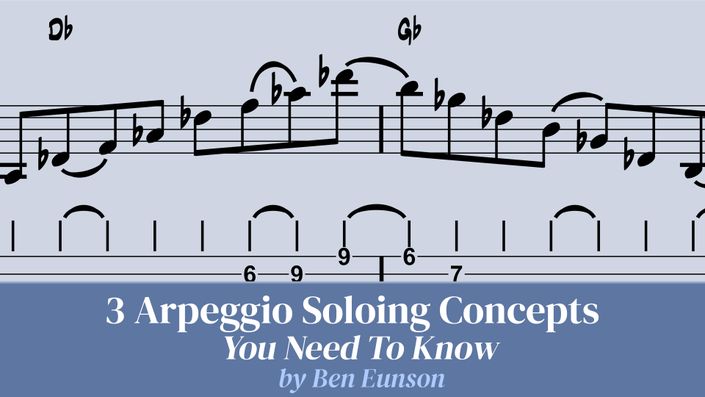
The BGC Bundle
(2025 Edition)
12 MASTERCLASSES:
- How To Practice Volumes 1, 2 & 3
- How To Warm Up
- 10 Etudes For Guitar Improvisation
- 20 Improvised Lines Over Turnarounds
- 20 Melodic Etudes For Rhythm Guitar
- 40 Improvised Lines For Guitar Soloing
- How To Solo With Triads
- How To Play Triad Pairs & Hexatonic Scales
- How To Solo With The Pentatonic Scale
- Improvising With J.S. Bach
-
BONUS PDF Lesson: 3 Arpeggio Soloing Concepts You Need To Know
Featuring 290+ video selections (featuring subtitles) with TAB/Notation, across a total of 12 guitar masterclasses!
Preview the Bundle:
Learn more about The BGC Bundle:
Q&A
12 MASTERCLASSES:
What will you cover in “How To Practice, Vol. 1: Scales, Modes, And What To Do With Them”?
- In How To Practice, Vol. 1, we will explore a wide variety of scales and modes on the guitar neck, utilizing multiple positions and fingerings. We will also focus on applying these scales and modes in the context of soloing over chord changes. Each example includes detailed explanations of the theoretical concepts behind the scales, modes, and their corresponding chord types. Mastering the scales and modes in this masterclass will help you develop a strong command of these essential materials on the guitar neck.
- This online masterclass includes access to 35 lesson selections, featuring a total of 32 lesson videos, divided across three sections. The lessons offer in-depth theoretical explanations, with all musical examples notated in both standard notation and TAB. All instructional videos are presented by Ben Eunson and include optional English subtitles.
What will you cover in “How To Practice, Vol. 2: Arpeggios, And What To Do With Them”?
- In How To Practice, Vol. 2, we will explore four types of triad arpeggios and twelve types of 7th chord arpeggios on the guitar neck, utilizing various positions and fingerings. We will also focus on applying these arpeggios in the context of soloing over chord changes. Each example includes detailed explanations of the theory behind the chords and arpeggios, as well as comprehensive fingering diagrams in both TAB and standard notation. Mastering the arpeggios in this masterclass will help you develop a strong command of these essential materials on the guitar neck.
- This online masterclass includes access to 53 lesson selections, featuring a total of 49 lesson videos, divided across four sections. The lessons provide in-depth theoretical explanations, with all musical examples notated in both standard notation and TAB. All instructional videos are presented by Ben Eunson and include optional English subtitles.
What will you cover in “How To Practice, Vol. 3: Developing A Linear Language”?
- In How To Practice, Vol. 3, we begin by building on foundational materials—scales, triads, and 7th chord arpeggios—and expanding upon them to demonstrate how to apply these materials practically within the context of chord changes. We also explore how to transform these basics into linear language for soloing.
- To maintain focus throughout How To Practice, Vol. 3, we will limit ourselves to two standard chord progressions frequently used in jazz and improvised music. These progressions were chosen because they include essential chord types (major, minor, diminished, and augmented) as well as practical examples of ii-V-I progressions (both major and minor)—vital components of nearly any chord progression you’ll encounter in modern contemporary music. These two progressions offer a harmonic framework that can be applied to virtually any other set of chord changes.
- This online masterclass includes access to 44 lesson selections, featuring a total of 40 lesson videos, divided into five sections (an introduction followed by Sections 1–4). The lessons provide in-depth theoretical explanations, with all musical examples notated in both standard notation and TAB. All instructional videos are presented by Ben Eunson and include optional English subtitles.
What will you cover in "How To Warm Up"?
- We will explore how to develop your approach to warming up on guitar through 20 etudes (with play-along backing tracks included), focusing on a variety of material-based exercises. The materials we'll cover include scales, arpeggios, and wide interval concepts. In-depth theoretical explanations are provided for each etude, detailing the conceptual ideas behind them.
- This online masterclass includes 21 lesson videos across four sections. All musical examples are notated in standard notation and TAB. The instructional videos are presented by Ben Eunson and include optional English subtitles.
What will you cover in “10 Etudes For Guitar Improvisation”?
- We will explore how to expand your improvisational language on the guitar neck through 10 etudes, each accompanied by play-along backing tracks. These etudes focus on the basic major and minor modes, harmonic minor modes, melodic minor modes, and diminished scales. To aid in our exploration of improvisational language, we will draw upon a wide range of triadic arpeggios, 7th chord arpeggios, and various intervallic structures found within these scales and modes. Each etude is accompanied by an in-depth theoretical explanation, detailing how each scale or mode functions in relation to its corresponding chord.
- This online masterclass includes access to 10 lesson videos across four sections, featuring in-depth theoretical explanations. All musical examples are notated in both standard notation and TAB. The instructional videos are presented by Ben Eunson and include optional English subtitles.
What will you cover in "20 Improvised Lines Over Turnarounds"?
- We will explore how to expand your understanding of the I-VI-ii-V progression—a four-chord progression commonly found in contemporary improvised music—through 23 exercises (including 3 introductory exercises) played over 10 variations of the progression. These exercises focus on soloing and deepening your understanding of harmony. Additionally, we’ll apply a variety of chord substitutions to these I-VI-ii-V examples, demonstrating how to incorporate these theoretical and linear concepts into your playing.
- This online masterclass includes 21 lesson videos across eleven sections, featuring in-depth theoretical explanations. All musical examples are notated in both standard notation and TAB. The instructional videos are presented by Ben Eunson and include optional English subtitles.
What will you cover in “20 Melodic Etudes For Rhythm Guitar”?
- We’ll focus on 20 rhythm guitar etudes, each accompanied by play-along backing tracks, to explore the melodic, linear, and chordal vocabulary shared between rhythm and lead guitar approaches. This approach results in a contemporary rhythm guitar style that I call Melodic Rhythm Guitar. You'll primarily encounter this style in contemporary jazz, R&B, and soul-influenced music. It draws heavily from the classic chord-melody techniques often heard in traditional jazz guitar.
- Through 20 etudes, we’ll dive deeply into this approach, applying it to a variety of chords, including Minor 7 chords (e.g., Ab Minor 7 and Ab Minor 11), Dominant 7 chords (e.g., Db13sus4 and Db7#5#9), and Major 7 chords (e.g., Gb Major 7).
- This online masterclass includes 21 lesson videos across five sections, featuring in-depth theoretical explanations. All musical examples are notated in both standard notation and TAB. The instructional videos are presented by Ben Eunson and include optional English subtitles.
What will you cover in “40 Improvised Lines For Guitar Soloing”?
- We'll focus on 40 Improvised Lines, exploring guitar soloing approaches derived from a variety of Scales & Modes, including the Ionian Mode (Major Scale), Dorian Mode, Mixolydian Mode, Melodic Minor Scale, Altered Scale, Half/Whole Diminished Scale, and a series of Pentatonic Scales.
- Each line featured in this masterclass will be presented in the form of a 4-bar phrase, and we will also explore the Triad/7th Chord Arpeggios that can be derived from each Scale/Mode.
- Additionally, we'll explore Wide Intervallic Leaps, Double Time Lines (32nd Note Lines), Arpeggio-Based Lines and Melody-Based Lines.
- This online masterclass includes access to 41 lesson videos across eight sections, featuring in-depth theoretical explanations. All musical examples are notated in both standard notation and TAB. The instructional videos are presented by Ben Eunson and include optional English subtitles.
What will you cover in "How To Solo With Triads"?
- We will explore how to expand your knowledge of triads on the guitar neck. This includes full explanations of how triads function diatonically within a given key, how to utilize primary triads for soloing, how triads can be used to create chord melody phrases, how to apply spread triads, and more. Our focus will be on soloing with major, minor, and diminished triads. Additionally, the masterclass includes five improvised phrases based solely on triads.
- This online masterclass includes access to 20 lesson videos divided into five sections, featuring in-depth theoretical explanations. All musical examples are notated in both standard notation and TAB. The instructional videos are presented by Ben Eunson and include optional English subtitles.
What will you cover in "How To Play Triad Pairs & Hexatonic Scales"?
- We will explore how to expand your knowledge of triad pairs and hexatonic scales on the guitar neck. This masterclass provides full explanations of how triad pairs and hexatonic scales can enhance the soloing language of any improvising guitarist. We’ll work through 27 detailed examples, demonstrating the theoretical concepts behind these materials and how they can be applied over a ii-V-I progression in the key of C Major.
- This online masterclass includes access to 19 lesson videos divided into four sections, featuring in-depth theoretical explanations. All musical examples are notated in both standard notation and TAB. The instructional videos are presented by Ben Eunson and include optional English subtitles.
What will you cover in "How To Solo With The Pentatonic Scale"?
- We will explore how to unlock the full potential of the pentatonic scale on the guitar neck. This masterclass provides in-depth explanations of how the pentatonic scale can be used in various contexts over minor, major, and dominant chords. We’ll examine a wide range of pentatonic examples, showcasing the many ways this 5-note scale can be applied when soloing over chords.
- This online masterclass includes access to 10 lesson videos divided into three sections, featuring in-depth theoretical explanations. All musical examples are notated in both standard notation and TAB. The instructional videos are presented by Ben Eunson and include optional English subtitles.
What will you cover in “Improvising With J.S. Bach”?
- We will explore how to expand and develop your soloing language by learning and analyzing Violin Partita No. 1 in B Minor, BWV 1002: II. Double—a violin variation composed by J.S. Bach and derived from Sonatas and Partitas for Solo Violin, a collection of six works composed between 1703 and 1720.
- This particular variation is an excellent study as it contains a rich array of arpeggios, scales, and melodies that can be easily adapted and applied within the context of contemporary harmony. Additionally, it fits perfectly within the range of a standard electric guitar with 20–22 frets.
- We will analyze 10 examples taken directly from Violin Partita No. 1 in B Minor, BWV 1002: II. Double, interpreting them through the lens of contemporary harmony. This analysis will assist in developing a modern improvisational language inspired by Bach's compositions.
- This online masterclass includes 12 lesson selections (with a total of 11 lesson videos) divided into two sections, featuring in-depth theoretical explanations. All musical examples are notated in both standard notation and TAB. The instructional videos are presented by Ben Eunson and include optional English subtitles.
What is the bonus PDF "3 Arpeggio Soloing Concepts You Need To Know"?
- The bonus PDF is a complete transcription of an arpeggio lesson (with TAB/notation) that discusses 3 of Ben Eunson's concepts for arpeggio-based soloing on guitar. Click here to watch the free accompanying lesson video on YouTube.
Does this masterclass contain downloadable files (PDFs, MP3s, Video files)?
- All masterclasses & mini-lessons feature downloadable PDF handbooks featuring transcriptions of every exercise in Standard Notation & TAB. All instructional videos and backing tracks are contained within the online courses, and require an internet connection. However, once you have made your purchase, you will have lifetime access to the online material.
How difficult would you say the material is?
- This material is best suited for intermediate to advanced guitarists.
How do I access the bundle?
- Once you have clicked “Purchase Bundle”, enter your payment and contact details (including your email address), complete your purchase and you will receive one email. This email contains access details to your purchase and is also a receipt.
- On the checkout page, make sure "Delivery address same as billing" is checked. We will not be delivering any physical goods to your address, but it is necessary to check this option as part of the online purchase process.
Do you offer refunds for bundle purchases?
-
We would like to ensure your satisfaction with this online bundle, and if you have any questions or concerns, please be in contact with info@bensguitarclub.com.
Bundle Contents:
12 Guitar Masterclasses + Bonus PDF lesson!
